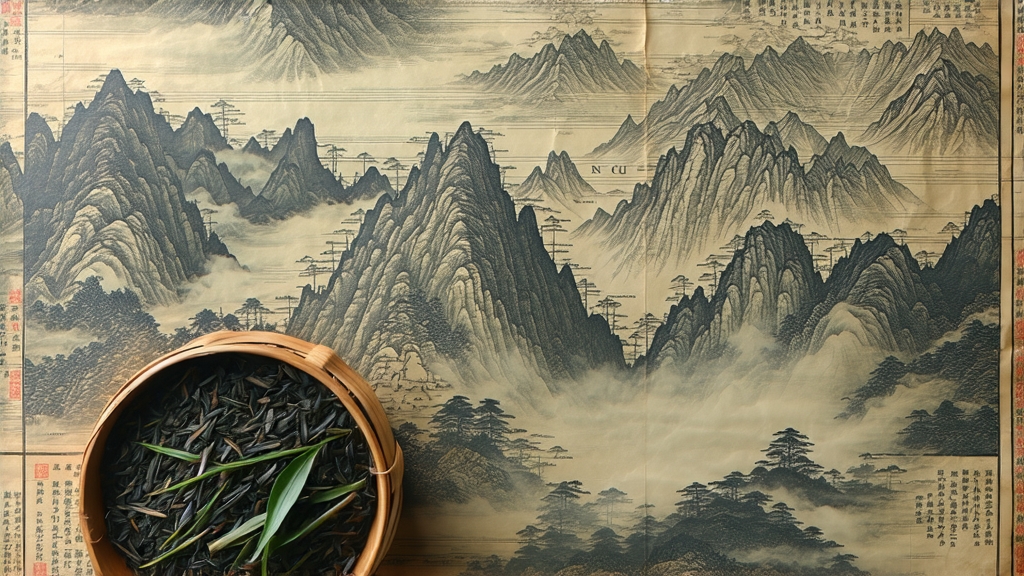
Tucked high on the northern rim of the Sichuan Basin, where the Min River slices through granite gorges and evergreen mists never quite lift, lies Meng Ding Mountain—literally “Mount of the Primordial Mist.” It was here, in the fertile Han dynasty soil of 53 BCE, that the world’s first reliably documented yellow tea was coaxed from a single-bud pluck and presented to a Han emperor. Locals still call the leaf Meng Ding Huang Ya, “the yellow bud of Meng Ding,” and every April they repeat a ritual unchanged for twenty-one centuries: before sunrise, girls and boys in indigo tunics climb 1,450 m of stone steps, bamboo baskets on their backs, to pick only the dew-tight buds sheathed in pale down. By law the harvest must finish before Grain Rain, ensuring fewer than 30,000 kg of finished tea reach global markets each year—scarcity that once justified its nickname “liquid gold.”
Meng Ding Huang Ya is not merely a tea; it is a time capsule of Chinese courtly taste. During the Tang dynasty it was couriered 2,000 km north by fast horse to Chang’an within seven days, the relay stations changing mounts every 30 li so that the emperor could taste spring before anyone else. Song scholars canonized it in the Cha Jing sequel “Meng Ding Pian,” praising its “orchid-born sweetness hidden in a chestnut shell.” When the Ming court shifted to Beijing, the tea travelled by riverboat down the Yangtze, then along the Grand Canal, arriving at the Forbidden City wrapped in yellow silk—an honor otherwise reserved for edicts. The Qing Qianlong Emperor was so enamored that he exempted Meng Ding monks from grain taxes in exchange for 300 jin annually, a levy that continued until the last emperor abdicated in 1912.
Botanically the cultivar is a local variant of Camellia sinensis var. sinensis known as “Meng Ding Xiao Ye Zhong,” small-leaf Meng Ding type. Its buds are shorter and plumper than those of Long Jing or Bi Luo Chun, carrying 22 % amino acids and a unique terpene profile dominated by hotrienol and linalool oxide—molecules that translate into the tea’s signature magnolia note. The mountain’s diurnal temperature swing (8 °C at dawn, 22 °C by noon) stalls photosynthesis, concentrating soluble sugars while the ubiquitous mist filters UV-B light, suppressing catechin bitterness. The result is a bud that is sweet even before human hands touch it.
The craft that turns this bud from green to golden is called “men huang,” literally “sealing yellow,” a slow oxidation sandwiched between two gentle kill-green phases. Picking begins at 5 a.m. when leaf temperature matches ambient, minimizing cellular bruising. Baskets are lined with fresh banana leaves to prevent compression; by 9 a.m. the buds arrive at the cliff-side workshop where they are spread on bamboo trays for six hours of withering in mountain shade—no sun-withering is allowed, as UV would lock in green chlorophyll. The first firing occurs at 120 °C for 90 seconds in a shallow wok brushed with Meng Ding spring water; this “sha qing” deactivates 85 % of polyphenol oxidase but leaves enough enzymes for the critical yellowing step. While still at 50 °C the buds are piled 5 cm deep inside a hemp-lined cedar box and left for 48 hours in a cave whose relative humidity hovers at 78 %. During this enclosed smothering the leaf re-absorbs its own moisture, turning from jade to maize as carotenoids oxidize faster than chlorophyll. A master craftsman checks the pile every three hours, sniffing for the transition from grassy to chestnut-magnolia; when the aroma peaks he restarts the wok at 80 °C, rolling the buds into tiny hooks that will dry into golden needles. Final drying is done over charcoal made from local walnut wood, the temperature descending from 70 °C to 40 °C across four hours while the tea master listens for the “ping” sound—tiny clicks that signal core moisture has fallen below 5 %. The entire cycle consumes 5 kg of fresh buds to yield 1 kg of finished tea, a 5:1 ratio twice that of most green teas.
Because the leaf is so delicate, Meng